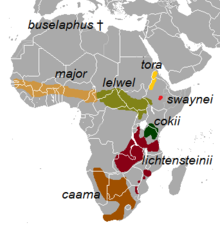South African hartebeest
| South African hartebeest | ||||||||||||
|---|---|---|---|---|---|---|---|---|---|---|---|---|

South African hartebeest in the Kgalagadi Transfrontier National Park |
||||||||||||
| Systematics | ||||||||||||
|
||||||||||||
| Scientific name | ||||||||||||
| Alcelaphus caama | ||||||||||||
| ( É. Geoffroy Saint-Hilaire , 1803) |
The South African hartebeest ( Alcelaphus caama ), also Southern hartebeest , red hartebeest , Cape hartebeest or Kaama called, is a occurring in southern Africa antelope from the group of hartebeest (Alcelphinae).
features
With a head-to-trunk length of 2 m, a shoulder height of 130 cm and a weight of 150 kg to 180 kg (males) or 105 kg to 120 kg (females), this antelope species is relatively large. The fur is shiny red-brown in color with a dark shadow from the shoulders to the base of the tail. Characteristic and a good distinguishing feature from the closely related Lichtenstein antelope ( Alcelaphus lichtensteinii ) are the black markings on the forehead and snout, as well as the black tail and the black outer sides of the legs. The mirror is light yellow. A small hump ( withers ) rises above the front legs so that the back line appears to be sloping. Both sexes have crescent-shaped, bent horns that can be half a meter long on average. The record is 74.93 cm. Hearing and smell are well developed, eyesight less. Frightened animals often run a short distance and then stop to look around. A warning snort is emitted in the event of danger. South African hartebeest can switch immediately from step to a canter gallop, which is quick and energy-saving. They can reach speeds of 70 km / h.

distribution
The South African hartebeest was found in the dry, western half of southern Africa from the extreme south of Angola through the center and east of Namibia , the center and south of Botswana to parts of South Africa. Today it only occurs in small parts of the original distribution area. It lives in dry savannahs and grass steppes with only a few trees. In particular, the large barricade fences that were built all over Botswana to prevent the spread of foot and mouth disease have led to a 70% collapse of the population.
Way of life
The South African hartebeest lives in herds of 10 to 20, sometimes up to 100 animals. These herds consist of females and young and are led by a dominant bull. Dominant bulls mark their territory with piles of dung and often stand demonstratively on small mounds or eroded termite burrows to display ownership. Femaleless bulls form bachelor herds, older bulls are loners. South African hartebeest feed almost exclusively on grass and, due to their narrow mouth, can choose between many low-nutrient grasses of high quality. In the dry season (southern winter) they also eat leaves. They mainly graze early in the morning and late in the afternoon. You drink regularly if possible, but you can do without water for a long time. A single young is born after a gestation period of eight months in southern summer between October and December.
Systematics
The South African hartebeest is often also regarded as a subspecies of the hartebeest ( A. buselaphus ), but is the sister species of the Lichtenstein hartebeest ( A. lichtensteinii ) and has received species status, since Alcelaphus buselaphus would be paraphyletic if the South African hartebeest as a subspecies in this Kind of asked.
literature
- Burger Cillié: Mammals, Handbook of Southern Africa. Biza Publications, 2011, ISBN 978-1-875093-47-2
- Gus Mills & Lex Hes: Mammals of Southern Africa. An illustrated encyclopedia. Ullmann publishing house, Cologne 1999, ISBN 3-8290-3610-8
Web links
Individual evidence
- ↑ Alcelaphus caama. In: Don E. Wilson and DeeAnn M. Reeder (Eds.): Mammal Species of the World. Johns Hopkins University Press, Baltimore MD 2005, ISBN 0-8018-8221-4
- ↑ Peter Arctander, Carsten Johansen & Marie-Agnes Coutellec-Vreto: Phylogeography of Three Closely Related African Bovids (Tribe Alcelaphini). PDF